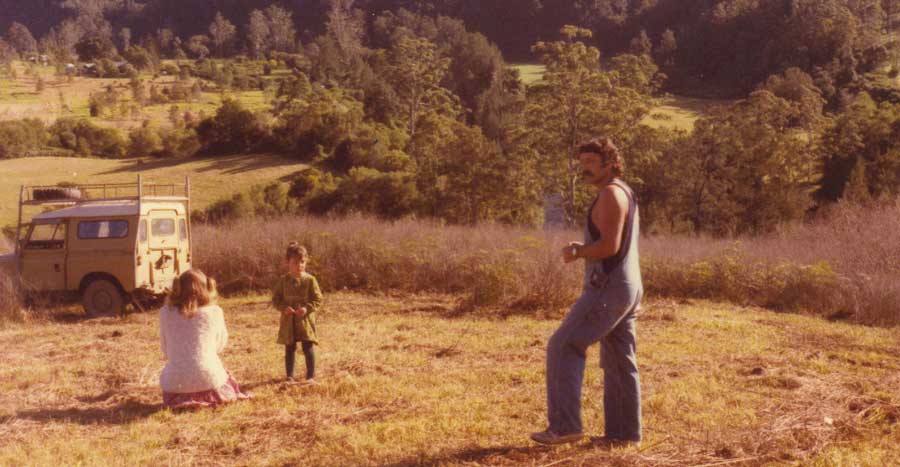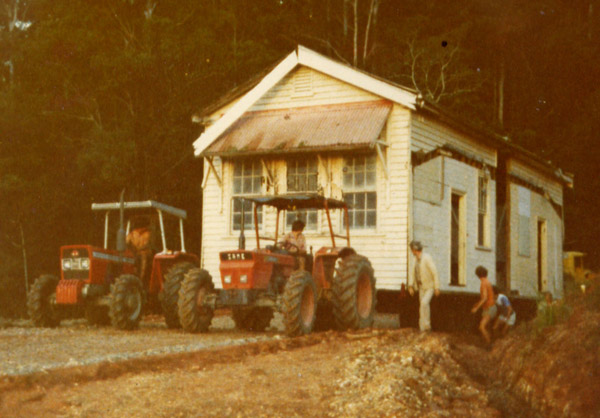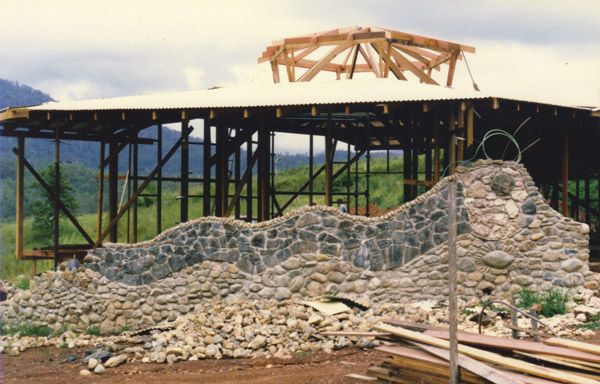
Looking at this early picture of Bob Sutherland, one of the founding teachers of the school, surveying the site that the school is now built on, it becomes possible to appreciate the scale of the task work undertaken by the founding families in establishing Chrysalis. At the bottom of the hill to their left you can see the open expanse of what is now the sports oval. They are standing approximately where the 1,2,3 classroom is built and all that is on the school site is long grass and mud tracks.
This article first published in Emerge in 2012 to commemorate the 30th anniversary of the school, compiled from material written by Marek Chodkiewicz, one of the schools early driving forces, gives an insight into the early life of Chrysalis as it attempted to get off the ground. It may help current members of the school become aware of the ground upon which we stand and appreciate just how far the school has come.
 The geographical setting of Chrysalis is, as we all know, unique, but the same might be said for the cultural and social setting , With regard to the first, imagine a valley in a subtropical area of Australia, through this valley runs a river fed by many waterfalls rushing from the mountains covered with rain forest. The river runs through luscious grasslands on which cattle graze. Here and there the colourful Jacaranda trees create a brilliant effect amongst the over powering greens of the valley. These are usually close to the dwellings of the original settlers.
The geographical setting of Chrysalis is, as we all know, unique, but the same might be said for the cultural and social setting , With regard to the first, imagine a valley in a subtropical area of Australia, through this valley runs a river fed by many waterfalls rushing from the mountains covered with rain forest. The river runs through luscious grasslands on which cattle graze. Here and there the colourful Jacaranda trees create a brilliant effect amongst the over powering greens of the valley. These are usually close to the dwellings of the original settlers.
The time is the early 1980’s and the valley has become an area where families who believe in an alternative lifestyle have come to settle. The Findhorn Community in Scotland has inspired a settlement in the valley called the ‘Homeland Foundation’ and it is in no small measure due to Homelands presence in the valley that Chrysalis school is flourishing today on the steep hillside of this valley.
The Homeland Foundation is a charitable trust and when it made 15 acres available to the school two years after the schools conception, things really started to move. However, before this happened, the inspired founders of the school had to experience the inevitable embryonic period and the first ‘birth pains’ that any worthwhile enterprise has to go through. As has already been mentioned, the area has many new settlers living the so called ‘alternative lifestyle: It is therefore not surprising that once the idea of an alternative form of education for the children of these families was mentioned, a variety of ideas surfaced.
 Into this scene, in August 1979, Lyn Jenick arrives at Homelands with her three children. She has also a property in the valley called Cunjevoi. Through a misunderstanding that she has offered land for the school to built on, fifty people attend a meeting at her home. They are full of expectations, Lyn is quite unaware of these expectations naturally but out of this gathering of fifty enthusiastic people, a working committee of eleven is formed. One of those there introduces the group to Steiner Education. The group receives a generous donation of $600 from a member of the Homeland Foundation.
Into this scene, in August 1979, Lyn Jenick arrives at Homelands with her three children. She has also a property in the valley called Cunjevoi. Through a misunderstanding that she has offered land for the school to built on, fifty people attend a meeting at her home. They are full of expectations, Lyn is quite unaware of these expectations naturally but out of this gathering of fifty enthusiastic people, a working committee of eleven is formed. One of those there introduces the group to Steiner Education. The group receives a generous donation of $600 from a member of the Homeland Foundation.
A number of meetings follow, but it soon transpires that there is a fundamental disagreement on the basis for the new school to be established in the valley. The group splits!
A meeting of the Rudolf Steiner group at the old Orama Church is attended by concerned self appointed mediators from the Dreamtime community who encourage reconciliation of the two groups. A very well attended meeting is held at the Bellingen Community Centre for that purpose with apparent success. Soon after that on the 26th November 1979, a small enthusiastic group of parents travel to Sydney to raise money selling ‘Devonshire teas’ at Lyn Jenick’s Queen Street property, all of this for the famous Queen Street Fair. Alas, for the first time in the history of the fair torrential rain falls, washing out the cream of the days takings. However $500 is banked in spite of prevailing conditions! Undaunted by this experience in Sydney, the same group, one week later on the 2 December, prepare for a festival on the banks of the Bellingen River at Lyn’s property Cunjevoi. Yet another $500 goes into the kitty, despite much higher hopes. Five hundred people had gathered on the day, the hottest day of the year! The labours of the long night for the dedicated ‘Lebanese salad makers’ produce only fermented Tabouli by 10 am and in spite of the generator run refrigerator struggling to do its duty, whipped cream for the “Devonshire Teas’ runs off the plates. The children’s hurdy-gurdy revolves in the blazing sun without a single excited child aboard, whilst the amazed and speechless canoeists paddle past 500 splashing children of nature!
 The reconciliation between the two groups is very short lived though. The final dissolution is made at an emotionally charged meeting at the Thora Hall. A god sent mediator and self appointed chairman arrives from nowhere and settlement is executed without a single shot being fired! The other group however, immediately begins to use the Thora Hall for their enterprise.
The reconciliation between the two groups is very short lived though. The final dissolution is made at an emotionally charged meeting at the Thora Hall. A god sent mediator and self appointed chairman arrives from nowhere and settlement is executed without a single shot being fired! The other group however, immediately begins to use the Thora Hall for their enterprise.
The founding members of the new ‘Cunjevoi School for Rudolf Steiner Education’ decide that a great deal of preparatory work has to be done before they are ready to start. A deeper understanding of the principles underlying Rudolf Steiner education is paramount. There is an obvious need for qualified teachers, quite apart from the capital to support the venture. A study group begins to meet regularly. Ideas are thrown around in a desperate, unenviable and frustrating attempt to raise funds in the country. On the 22nd of January 1980 a very successful seminar is attended by 100 people. Alan Whitehead from ‘Lorien Novalis’, a Rudolf Steiner School in Dural, conducts the seminar. Afterwards a very critical article appears in the local paper entitled: ‘Vale, The Year of the Child’. The article provided Alan Whitehead however with an opportunity to reply and clear up some misinterpretations about Rudolf Steiner’s philosophy and indications for education.
 1980 is an arduous year of meetings, not always well attended. The small core group; Lyn, Sally and Jack, the architect, study and search desperately for the answers to the manifestation of their children’s dream school. A young couple and a young single man elect to commence training at ‘Lorien Novalis’ but all drop out as the year proceeds. In August the ‘Free school’ operating in Thora Hall dissolves and a few of the original parents approach Lyn to re-unite and use her ‘Cunjevoi’ barn for the third term. The proposition for a ‘re-marriage’ is agreed upon with the understanding that the school is in the process of becoming officially registered as a school for Rudolf Steiner Education, limited by guarantee.
1980 is an arduous year of meetings, not always well attended. The small core group; Lyn, Sally and Jack, the architect, study and search desperately for the answers to the manifestation of their children’s dream school. A young couple and a young single man elect to commence training at ‘Lorien Novalis’ but all drop out as the year proceeds. In August the ‘Free school’ operating in Thora Hall dissolves and a few of the original parents approach Lyn to re-unite and use her ‘Cunjevoi’ barn for the third term. The proposition for a ‘re-marriage’ is agreed upon with the understanding that the school is in the process of becoming officially registered as a school for Rudolf Steiner Education, limited by guarantee.
In September Kathy Roberts, a Primary school teacher is hired and more than a dozen children are accommodated for a term in the beautiful slab-barn at ‘Cunjevoi’. The barn becomes alive with children’s voices and laughter.
In January 1981, with 11 children enrolled in the school and NO Steiner-trained teacher yet manifested, we hope for the seemingly impossible. Destiny now sends us Lorelle, who has one year’s training at ‘Lorien Novalis’. She offers her services. The school is now officially operating as a Rudolf Steiner School in Lyn’s home ‘Cunjevoi.’ During mid-term Lorelle becomes ill and Alan Whitehead sends Marek Chodkiewicz from his staff at ‘Lorien Novalis’. Marek stays for three weeks and in that time arranges for a ‘Winter-festival’ at the top of the valley with which he falls in love.
 In November ‘81 an open day is organized at ‘Cunjevoi.’ 120 people are invited, amongst them dignitaries from the district, i.e. the Chairman of the Council. As a direct consequence 20 new enrolments for the school are accepted. Moreover the ‘Homeland Foundation’ now offers 15 acres of beautiful hillside at a ‘peppercorn’ rent. The need tor buildings and fully qualified teachers are now the most important factors keeping the founding members busy.
In November ‘81 an open day is organized at ‘Cunjevoi.’ 120 people are invited, amongst them dignitaries from the district, i.e. the Chairman of the Council. As a direct consequence 20 new enrolments for the school are accepted. Moreover the ‘Homeland Foundation’ now offers 15 acres of beautiful hillside at a ‘peppercorn’ rent. The need tor buildings and fully qualified teachers are now the most important factors keeping the founding members busy.
Life, the great teacher and provider, had again rewarded the efforts of the dedicated pioneers of this school in its usual mysterious and loving way. Lyn finds the oldest State school in the area in Fernmount in January ‘82. The building is bought for $ 1,500.00 and now needs to be transported onto the site. Unfortunately that autumn is very wet and the transport has to be postponed. When it is finally accomplished in April ‘82 it proves even more hazardous than expected. Another, identical classroom is sourced from Whiskey Creek up by Dorrigo. It is now also possible to persuade Marek and Carol to consider settling in the valley after a house has become available for them. How glad we all are to welcome the musically talented Marek and his family. Marek had taught for seven years at ‘Lorien Novalis’ so he is our first experienced Steiner teacher. Prior to his teaching career he has also worked as a graduate electrical engineer, played soccer at professional level and is in his spare time a dedicated musician.
 Yet another happy and exciting act of destiny befalls our little school in the valley. The Atherton Tablelands in Northern Queensland had sent Bob Sutherland to study Steiner Education at ‘Lorien Novalis’. Bob is a graduate of zoology. Here he meets Jane Michaelis who had also gone there for the training. Bob, his wife Jan, and Jane Michaelis are, all three, drawn to our magical valley to join our staff. There are now 31 pupils in the school.
Yet another happy and exciting act of destiny befalls our little school in the valley. The Atherton Tablelands in Northern Queensland had sent Bob Sutherland to study Steiner Education at ‘Lorien Novalis’. Bob is a graduate of zoology. Here he meets Jane Michaelis who had also gone there for the training. Bob, his wife Jan, and Jane Michaelis are, all three, drawn to our magical valley to join our staff. There are now 31 pupils in the school.
During the third term Dorothy Pollard, a psychology graduate, joins the school. She had left the area to take her training at ‘Lorien Novalis’. She now helps Jane in the Kindergarten and Marek and Bob in their classes.
Classroom extensions, more furniture and playground equipment and an extensive library keeps parents and teachers busy all that year. On the 31st of October 1982 the Company is formed and the name of the school is changed to ‘Chrysalis.’ Chrysalis in this case means ‘Golden Home’ and implies a protected place for formed artistic change. At the school beauty, accuracy and care are woven together to give wings to the children’s enthusiasm for learning yet providing them with meaningful practical skills that make them into productive adults.
 At this point it must be understood that the school is run by a committee legally constituted to give parents and teachers equal voice, it is this power of involvement and dedication by the patents and teachers, that has helped to see the school grow so dramatically, considering there was little initial collateral and most parents are on a low income.
At this point it must be understood that the school is run by a committee legally constituted to give parents and teachers equal voice, it is this power of involvement and dedication by the patents and teachers, that has helped to see the school grow so dramatically, considering there was little initial collateral and most parents are on a low income.
Marek himself notes that parental involvement was integral to the establishment of the school. Most of the children’s parents were ‘new settlers’ who had moved from the cities to forge a better life for themselves and their families. They ‘worked like Trojans’ and, given the high unemployment, ‘sweat equity’ often replaced school fees.
The school itself happily accommodated this ethic, looking to the individual skills of the parents to not only build the required infrastructure, but also to facilitate the hands on arts program so vital to Steiner Education. Frequent working bees created an ethos of a community working together to build a common future and a parent education program helped them to see their efforts in a broader perspective. Unusual and innovative architecture furthered their sense that something new and wonderful was taking place, and by the late eighties the school population topped 150. (Thanks also to Will Douglas for material from his essay on the history of the school.)
